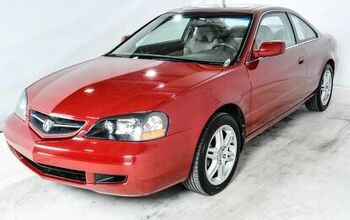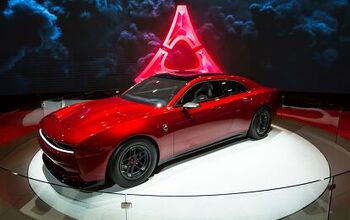Digestible Collectible: 2003 Honda S2000

Throughout the ’80s and ’90s, Honda could do no wrong in enthusiasts’ eyes. Nearly everything was a hit. The CRX, Civic, Prelude, NSX and Integra all handled beautifully, taking well to both motorsport and unwise modification.
Near the turn of the century, however, some folks decreed that Honda had lost its way. The double-wishbone suspension was phased out in most cars, replaced by the space-saving, less-expensive McPherson strut. Honda enthusiasts decided that this change fundamentally altered the character of the cars.
As it turns out, Honda had one last round in the chamber.
The S2000 was unlike any other Honda before or since. Not since the very early ’70s had anything from Honda come with an otherwise traditional front engine, rear-drive configuration. Clearly an upscale competitor to the Miata, and perhaps a budget alternative to the Z3, the S2000 quickly found favor among those who wanted plenty of power in a compact, nimble package. Two-hundred-and-forty horsepower out of a 2-liter is remarkable even 15 years later.
This 2003 Honda S2000 at $14,900 seems priced right in the sweet spot. I’ve seen ratty cars for $5,000-8,000, and pristine cars up over $20,000, but for a car that had few major changes over a nine-year model run, never mind the fanbois internet-fighting over the AP1/AP2 differences, generally the best advice is to buy the cleanest car you can afford.
This car is not too far from home. Perhaps I’ll go give it a drive this weekend — assuming I fit. The one and only time I tried to drive an S2000, I had to plant my somewhat-voluminous rear on the side bolsters as I couldn’t slide all the way in. I’ve lost weight in the interim, so I might be able to make this happen. I love the dark grey paint, though I’d prefer to see the red leather interior.
The last few years have been somewhat quiet for fans of new Hondas, as we wait for the new Civic Si and Type-R. Let’s hope they are worth the wait.

Some enthusiasts say they were born with gasoline in their veins. Chris Tonn, on the other hand, had rust flakes in his eyes nearly since birth. Living in salty Ohio and being hopelessly addicted to vintage British and Japanese steel will do that to you. His work has appeared in eBay Motors, Hagerty, The Truth About Cars, Reader's Digest, AutoGuide, Family Handyman, and Jalopnik. He is a member of the Midwest Automotive Media Association, and he's currently looking for the safety glasses he just set down somewhere.
More by Chris Tonn
Latest Car Reviews
Read moreLatest Product Reviews
Read moreRecent Comments
- Theflyersfan The wheel and tire combo is tragic and the "M Stripe" has to go, but overall, this one is a keeper. Provided the mileage isn't 300,000 and the service records don't read like a horror novel, this could be one of the last (almost) unmodified E34s out there that isn't rotting in a barn. I can see this ad being taken down quickly due to someone taking the chance. Recently had some good finds here. Which means Monday, we'll see a 1999 Honda Civic with falling off body mods from Pep Boys, a rusted fart can, Honda Rot with bad paint, 400,000 miles, and a biohazard interior, all for the unrealistic price of $10,000.
- Theflyersfan Expect a press report about an expansion of VW's Mexican plant any day now. I'm all for worker's rights to get the best (and fair) wages and benefits possible, but didn't VW, and for that matter many of the Asian and European carmaker plants in the south, already have as good of, if not better wages already? This can drive a wedge in those plants and this might be a case of be careful what you wish for.
- Jkross22 When I think about products that I buy that are of the highest quality or are of great value, I have no idea if they are made as a whole or in parts by unionized employees. As a customer, that's really all I care about. When I think about services I receive from unionized and non-unionized employees, it varies from C- to F levels of service. Will unionizing make the cars better or worse?
- Namesakeone I think it's the age old conundrum: Every company (or industry) wants every other one to pay its workers well; well-paid workers make great customers. But nobody wants to pay their own workers well; that would eat into profits. So instead of what Henry Ford (the first) did over a century ago, we will have a lot of companies copying Nike in the 1980s: third-world employees (with a few highly-paid celebrity athlete endorsers) selling overpriced products to upper-middle-class Americans (with a few urban street youths willing to literally kill for that product), until there are no more upper-middle-class Americans left.
- ToolGuy I was challenged by Tim's incisive opinion, but thankfully Jeff's multiple vanilla truisms have set me straight. Or something. 😉


































Comments
Join the conversation
My only gripe against the S2000 is the seats that place you practically on the cabin floor. My 6' height meant that my thighs were uncomfortably canted, knees-up, with no support. Although I had a little headroom, the car is a terrible ride for taller people.
I thought Honda cars from the early 70s were front wheel drive as well (the N600 sedan/Z600 Coupe were at least). Honda does make RWD vehicles, but they are kei truck/vans sold in Japan. Honda's first four wheeled vehicle was a RWD truck IIRC. I have never had the pleasure of driving an S2000. Given their ability to hold their value as they do, I may never get the chance to own one, but Id sure like to drive one at some point. Speaking of the Z600 Coupe, I want one so bad, it could almost be considered an obsession. Gotta be Advacado Green, orange or yellow. I have a bright yellow Z600 Coupe from an old JDM advertisement as my background on my PC, its been that way for several years (although admittedly, I rarely use the PC anymore).